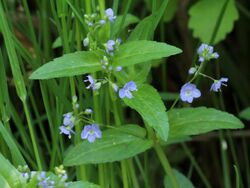Biology:Veronica americana
| Veronica americana | |
|---|---|

| |
| Scientific classification | |
| Kingdom: | Plantae |
| Clade: | Tracheophytes |
| Clade: | Angiosperms |
| Clade: | Eudicots |
| Clade: | Asterids |
| Order: | Lamiales |
| Family: | Plantaginaceae |
| Genus: | Veronica |
| Species: | V. americana
|
| Binomial name | |
| Veronica americana Schwein. ex Benth.
| |
Veronica americana, variously called American brooklime[1] or American speedwell,[1][2] is a plant native to temperate and arctic Asia and North America[1] where it grows in streams and bottomlands.
It is a herbaceous perennial with glabrous stems 10–100 cm long that bear terminal or axillary racemes or spikes of soft violet flowers. The leaves are 1.5–8 cm long and 3 to 20 times as long as wide, short-petiolate, glabrous, serrate to almost entire.[3]
The plant can be confused with Scutellaria (skullcap) and other members of the mint family. Members of the mint family have square sided stems, and Veronica species have rounded stems.[4]
Uses
American speedwell is used both as food and as a medicinal plant.[citation needed] It is rich in nutrients and is reported to have a flavor similar to that of watercress.[5] As long as the water source is not contaminated, the entire plant (sans roots) can be eaten raw.[6]
References
- ↑ 1.0 1.1 1.2 {{citation | mode = cs1 | title = Veronica americana | work = Germplasm Resources Information Network (GRIN) | url = | publisher = [[Organization:Agricultural Research ServAgricultural Research Service (ARS), United States Department of Agriculture (USDA) | access-date = 2008-03-30 }}
- ↑ "Veronica americana Schwein. ex Benth.". PLANTS Profile. United States Department of Agriculture; Natural Resources Conservation Service. http://plants.usda.gov/java/profile?symbol=VEAM2.
- ↑ "Veronica americana". WTU Herbarium Image Collection. Burke Museum, University of Washington. http://biology.burke.washington.edu/herbarium/imagecollection.php?Genus=Veronica&Species=americana.
- ↑ Edible and Medicinal Plants of the West, Gregory L. Tilford, ISBN:0-87842-359-1
- ↑ Reiner, Ralph E. (1969). Introducing the Flowering Beauty of Glacier National Park and the Majestic High Rockies. Glacier Park, Inc.. pp. 96.
- ↑ Nyerges, Christopher (2017). Foraging Washington: Finding, Identifying, and Preparing Edible Wild Foods. Guilford, CT: Falcon Guides. ISBN 978-1-4930-2534-3. OCLC 965922681. https://www.worldcat.org/oclc/965922681.
Further reading
| Wikimedia Commons has media related to Veronica americana. |
- Moreno-Escobar, Jorge; Alvarez, Laura; Rodriguez-Lopez, Veronica; Marquina Bahena, Silvia (2013). "Cytotoxic glucosydic iridoids from Veronica americana". Phytochemistry Letters 6 (4): 610–613. doi:10.1016/j.phytol.2013.07.017. Bibcode: 2013PChL....6..610M.
Wikidata ☰ Q2074744 entry
 |

